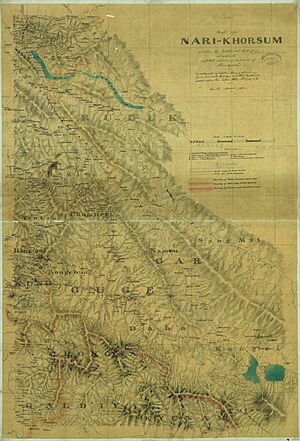Henry Strachey (explorer) facts for kids
Quick facts for kids
Sir
Henry Strachey
|
|
|---|---|
| Born | 1816 |
| Died | 1912 |
| Known for | Extensive explorations and surveys in Western Tibet |
| Honours | Patron's Medal |
Sir Henry Strachey (born 1816, died 1912) was a British officer who worked for the British in India. He was part of the Bengal Army, which was the army of the British East India Company. Even though people from Europe were usually not allowed into Tibet, Henry Strachey explored parts of western Tibet in the late 1840s. He was known for his important surveys and maps of these areas. His brothers, Sir Richard Strachey and Sir John Strachey, were also famous.
Contents
Exploring Tibet's Mountains
In 1846, Henry Strachey was a lieutenant in the 66th Regiment of Bengal Native Infantry. He explored the Tibetan areas around two lakes: Manasarovar and Rakshastal. He discovered a natural channel connecting these lakes. This finding helped show that Lake Manasarovar was the true source of the Sutlej River, not Lake Rakshastal. His brother, Richard Strachey, continued exploring these lakes in 1848.
Mapping Borders in the Himalayas
In 1847, Strachey joined a special group called a boundary commission. This group was set up to decide the border between Tibet and Ladakh. Ladakh was a princely state in Jammu and Kashmir. The British wanted to make sure the border was clear to prevent future fights. However, the Tibetan authorities did not join the commission. The group worked from Leh, in Ladakh, and created a description of the border.
In 1848, Henry Strachey made another important discovery. He was the first European to find the Siachen Glacier. This is a huge glacier in the Himalayas. He even climbed about 2 miles up the glacier!
Journey Through Niti Pass
In 1849, Henry Strachey and his brother Richard briefly entered Tibet. They followed a route called the Niti Pass, which starts from Garhwal. During their journey, they visited important places like Tholing Monastery and Hanle.
Henry Strachey's work in surveying Tibet was very important. Because of his amazing explorations and maps, he received the Patron's Medal in 1852. This is a special award from the Royal Geographical Society, which is a famous group that supports geography and exploration.
Family Life
On September 6, 1859, Henry Strachey, who was then a captain, married Joanna Catherine. She was from Cape Town, South Africa. They had one child, a daughter named Julia Charlotte. Julia later married a lawyer named William Chance in 1884. Julia was also an amateur sculptor and supported the Arts and Crafts movement. She and her husband lived in a house called Orchards in Surrey, England. A famous architect named Edwin Lutyens designed their home.
Writings
Henry Strachey wrote about his discoveries. One of his most famous writings is:
- "Physical Geography of Western Tibet", published in the Journal of the Royal Geographical Society in 1853.


